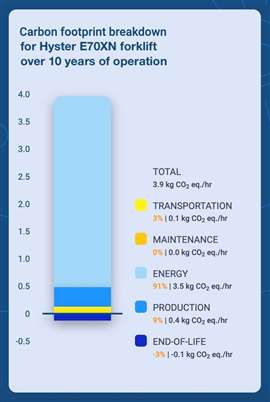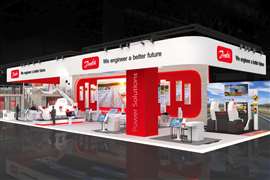Read this article in Français Deutsch Italiano Português Español
Assessing the lifetime emissions of electric forklifts
06 December 2023
 Hero photo OneCharge forklift assessment article (Photo: OneCharge)
Hero photo OneCharge forklift assessment article (Photo: OneCharge)
As working vehicles, forklifts can be in use over two or three shifts, possibly up to 20 hours each day. This could appear efficient, but high utilization drives up the Scope 2 (energy source) share of emissions to over 90%, even without any Scope 1 (tailpipe) emissions. Scope 3 emissions from the manufacturing of both the forklift and its battery pack account for an estimated 9% of the total carbon footprint.
Electric forklifts offer several environmental benefits which can significantly reduce the carbon footprint of warehouses and distribution centers. However, these operations are not as yet net-zero, meaning that some US companies are required by law to track and report their emissions (see Emissions reporting box at end of article).
Energy usage
Manufacturing of a passenger EV and its battery accounts for 34% of total emissions, calculated over a 16-year lifespan or 160,000 miles. Energy used in the vehicle makes up the remaining 66%. According to the model used by the European Rental Association, generation of the electricity used to charge a forklift battery exceeds 90% of its total lifetime carbon footprint, when calculated over a 10-year lifespan.
Both calculations are based on average CO2 emissions from electricity-generating plants in the US, but the reality is more nuanced. Ten percent of electricity generated in the US in 2023 came from renewable sources. Those power plants that still rely on fossil fuels differ dramatically; coal generates about double the CO2 of natural gas.
California and Texas have made noteworthy steps to increase the share of renewables in their respective energy portfolios, while Arkansas still gets more than 35% of its electricity from coal. The bottom line is that a forklift’s carbon footprint will differ dramatically from state to state, depending on the fuel used in electricity generation.
‘Scope’ definitions
Scope 1
Emissions from operating the equipment (tailpipe, etc.)
Scope 2
Emissions relating to generated energy used in the equipment
Scope 3
Emissions from the manufacturing (mining, refining, processing, etc.) of key components (steel, copper, battery metals, plastics, etc.)
Steel production
Assembly of the forklift and battery pack require resources and energy. This extends from mining and refining of raw materials, through to component production.
 Carbon footprint for Hyster E45-70XN forklift over 10 years (Photo: OneCharge)
Carbon footprint for Hyster E45-70XN forklift over 10 years (Photo: OneCharge)
Calculations from OneCharge are based on a Hyster E45-70XN electric forklift with a chassis-integrated lithium-ion battery. Total truck weight without a battery is 3400 kg (7500 lb), of which about 3,175 kg (7000 lb) is steel.
Globally, steel production generates approximately 9% of all human-sourced emissions each year. That’s more than any other heavy industry, including cement and chemical production. Typically, integrated (coal burning) steelmaking generates nearly two metric tonnes of CO2 for every metric ton of steel produced.
But while about 30% of steel produced in the US is made in integrated mills, about 70% is made using more than 100 electric-arc furnaces. For the rest of the world, the reverse is generally true, with 70% produced in coal-powered furnaces. The other 30% comes from scrap metal.
Steel from scrap has a clear advantage. According to the Steel Manufacturer’s Association 2022 report, electric-arc furnaces in the US generate about 0.37 metric tonnes of CO2 for every 1 metric tonne of crude steel produced, or roughly 75% less than integrated mills
Recycling
End-of-life disposal of electric forklifts must be carried out responsibly to minimize any environmental impact. Fortunately, many manufacturers and industry organizations have established recycling and battery repurposing programs. By participating in these programs, companies can actively contribute to reducing the environmental impact of electric forklifts; the model we used as a baseline indicates a 2% reduction of the total emissions with an average ‘best practice’ approach to recycling.
Lifecycle Assessment
OneCharge used the European Rental Association CO2 calculator to estimate the total footprint of a Hyster E70XN. The calculations are based on 10 years of operation with a high level of equipment utilization (2500 hours per year). The total carbon footprint equates to 97.5 tons of CO2 with the following make up:
- Energy use: 87.5 tons of CO2 equivalent
- Manufacturing (battery and vehicle): 10 tons of CO2 equivalent
 Hyster electric forklift
Hyster electric forklift
Logistics for getting the forklift to its operating facility is compensated for through recycling and battery repurposing efforts.
Conclusion
With zero tailpipe emissions, electric forklifts offer a more sustainable alternative to their fossil fuel counterparts. By eliminating tailpipe emissions and reducing noise pollution, these vehicles can significantly improve environmental conditions within part and distribution warehouses.
Taking a comprehensive approach to evaluating the environmental impact of forklifts is essential. Businesses will soon be required to report not only the direct emissions from operations but also those from the electricity generation used to power their forklifts and the emissions generated during manufacturing.
 Maxim Khabur
Maxim Khabur
But their environmental impact extends beyond the operational phase. Carbon emissions related to power generation represent most of their total CO2 footprint.
Since more than 90% of the total carbon footprint of electric forklifts comes from energy generation, efforts to reduce their total GHG emissions should focus on procuring cleaner electricity, improving operational energy efficiency and exploring ways to source power from renewable sources, such as solar and wind.
Maxim Khabur is director of Marketing at OneCharge, a US-based manufacturer of li-ion batteries. He is also chairman of the Advanced Energy Council.
Emissions reporting
The United States currently requires facilities emitting more than 25,000 metric tons of CO2 per year to report greenhouse gas emissions to the Environmental Protection Agency (EPA). Reporting of these Scope 1 emissions has been a requirement since 2009.
California’s Senate Bill 253, known as the Climate Corporate Data Accountability Act, requires companies with over $1 billion in annual revenue to publicly report their Scope 1, 2, and 3 GHG starting in 2026 (covering 2025). This is pivotal, as Scope 3 emissions often account for more than 90% of an organization’s climate impact and are notoriously difficult to measure.
The bill stipulates that companies will have to submit emissions calculations to a digital reporting platform, with the disclosures made easily comprehensible to residents, investors and other stakeholders. They will also be required to hire independent auditors to verify their reported emissions.
It will take time, but chances are that this practice will eventually be adopted in the rest of the US.
POWER SOURCING GUIDE
The trusted reference and buyer’s guide for 83 years
The original “desktop search engine,” guiding nearly 10,000 users in more than 90 countries it is the primary reference for specifications and details on all the components that go into engine systems.
Visit Now
STAY CONNECTED




Receive the information you need when you need it through our world-leading magazines, newsletters and daily briefings.
CONNECT WITH THE TEAM














